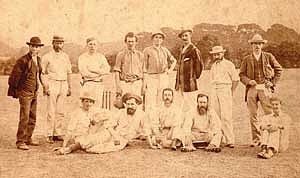
From the Steyning Museum archives - Cricket played by the Men of Steyning
From the Steyning Museum archives - Cricket played by the Men of SteyningThere was a mention, in last month’s article, of James Irish – a clockmaker of Steyning – who distinguished himself by scoring 70 notches in a cricket match in 1772. With the cricket season now in full swing we decided to delve further into the Museum’s archive to see what else it had to tell us about cricket as it used to be played by Steyning men.
The earliest report of a cricket match involving a team from Steyning is much earlier. It is in the diary of Thomas Marchant, a yeoman farmer of Hurstpierpoint. On June 3rd 1721 he notes “A Cricket Match in ye Sandfield [at Hurst] between Stenning and our parish, the latter won in one inning”. A return match was scheduled three days later when he reports that “Will went to Stenning with ye rest of our Parish to play a Cricket Match, but the Weather so bad that they could not [play]”.
One match lost and one rained off does not seem too out of the ordinary for any week in early June. But, of course, it was out of the ordinary. It was some years before the first known laws of cricket were formulated (in which the players are referred to as “gamesters”) and almost thirty years before the formation of the Hambledon Cricket Club which claims to be the ‘cradle of cricket’.
By 1856 Steyning were regularly playing matches and recording the results. The first detailed scorecard for a match – played on 29th July against Horsham – shows that Steyning did not cover themselves in glory; in their two innings they scored 34 and then 33 with no one reaching double figures.
Needless to say Horsham won that one. However in two games against Worthing a month earlier Steyning had won both of them. During their home game, which took place “in the White Horse field”, “Mr. R. Skinner [a master tailor by trade] was much admired for bowling seventeen maiden overs in succession.” An impressive achievement – even if overs at that time were of only five balls rather than six. Cricket Club accounts from a few years later indicate that Mr. Skinner would, in all probability, have received a 5/- man of the match award, a sum paid to Steyning’s best player in any one game. Interestingly only those not viewed as ‘gentlemen’ qualified for this payment.
The umpire also got 5/- and the scorer 2/6, even when it was just a fun match. It was just such an occasion in 1862 when, due to some pretty erratic fielding and wicket keeping, the “Married Men” ran five byes off one ball from the “Single Men” of Steyning – which was eventually the winning margin for the Married Men.
The 1870’s were a time of change for the Cricket Club. Numerous receipts and some photographs survive. So we know that 300 “turfs from the hill” were purchased to re-lay the pitch with close cropped downland grass. The grass was then cut with a mower drawn by the brewery horses. Leather boots were made for the horses by the local saddler to minimize damage to the pitch and the heavy roller was hauled by Mr. Gates men – who were then suitably rewarded with beer.
The scoring and changing took place in an old tent which needed such frequent repair that, in 1878, it was eventually replaced by a purpose-built ‘dressing shed’ which was located at the top of the ground, not the bottom as it is now.
By then Steyning cricketers were using ‘leg guards’ and ‘gauntlets’ (pads and gloves). These may have been much patched and repaired and owned by the club rather than the individual players but the days of two stump wickets and underarm bowling – and no pads or gloves –, which James Irish and the men whose games against Hurstpierpoint in 1721 would have been familiar with, were long gone.

